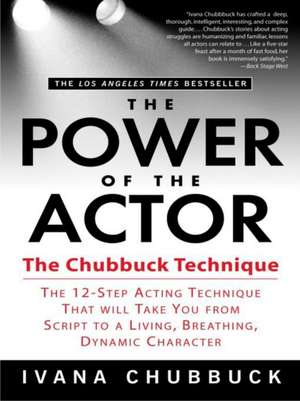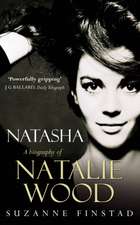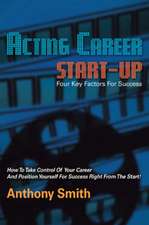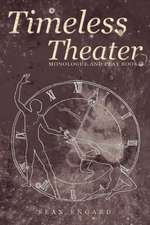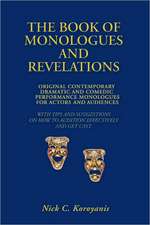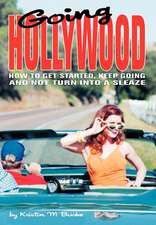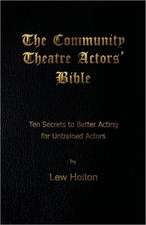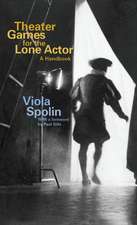The Power of the Actor: The Chubbuck Technique
Autor Ivana Chubbucken Limba Engleză Paperback – 31 aug 2005 – vârsta de la 18 ani
The first book from the instructor who has taught Charlize Theron, Brad Pitt, Elisabeth Shue, Djimon Hounsou, and Halle Berry, The Power of the Actor guides you to dynamic and effective results. For many of today’s major talents, the Chubbuck Technique is the leading edge of acting for the twenty-first century. Ivana Chubbuck has developed a curriculum that takes the theories of the acting masters, such as Stanislavski, Meisner, and Hagen, to the next step by utilizing inner pain and emotions, not as an end in itself, but rather as a way to drive and win a goal.
In addition to the powerful twelve-step process, the book takes well-known scripts, both classic and contemporary, and demonstrates how to precisely apply Chubbuck’s script-analysis process. The Power of the Actor is filled with fascinating and inspiring behind-the-scenes accounts of how noted actors have mastered their craft and have accomplished success in such a difficult and competitive field.
Preț: 132.39 lei
Nou
25.34€ • 26.17$ • 21.09£
Carte disponibilă
Livrare economică 04-18 martie
Livrare express 18-22 februarie pentru 42.55 lei
Specificații
ISBN-10: 1592401538
Pagini: 388
Dimensiuni: 153 x 223 x 27 mm
Greutate: 0.41 kg
Editura: GOTHAM BOOKS
Recenzii de la cititorii Books Express
Irina Diana Calu a dat nota:
Totul este, ca de obicei, mult peste asteptari! Astfel, doresc sa multumesc Book Express pentru perseverenta si daruire. Sunteti o echipa extraordinara, atenta si dedicata! Mult success in continuare!
Recenzii
"Ivana Chubbuck is the premier acting coach of the twenty-first century.... Ivana’s innovative methods of teaching both complement and rival those methods of the great teachers of the past.... Under Ivana’s tutelage, the course of my career and depth of my work have changed dramatically."—Halle Berry
Notă biografică
Ivana Chubbuck founded Ivana Chubbuck Studios more than twenty years ago, becoming one of the most sought-after acting coaches in Hollywood. She also works as a script consultant and has been widely profiled in the media.
Extras
Acting is a complex and elusive art to define. Yet almost everyone can tell good acting from bad acting—or good acting from brilliant acting. Why can one actor be riveting in a play and another actor be dull and boring in the very same play, doing the same character, the same lines? If it were just the script, the beauty of its language, the artful turn of a phrase, we would only need readings. But the words are not just read with sterility from the page. They are performed and brought to life by actors. Every actor knows that discovering and understanding your personal pain is an inherent part of the acting process. This has been true since Stanislavski. The difference between the Chubbuck Technique and those developed in the past is that I teach actors how to use their emotions not as an end result, but as a way to empower a goal. My technique teaches actors how to win.
If you look closely at virtually all drama and comedy—in fact, all literature—you will find that the will to win is the one constant element. In every story, a character wants or needs something (their goal)—love, power, validation, honor—and the story documents the way in which they try to win that particular desire or need. While what and how the characters try to win is defined in many ways and takes many forms and shapes, when you distill these goals down, you find that every character’s conflict and struggle is about fighting to win whatever their goal is.
I teach actors how to win because this is what people do in real life! They go after what they want. Interesting and dynamic people go after what they want in interesting and dynamic ways, creating greater emotion and intensity in realizing these goals. They do this subconsciously, whereas the actor must understand himself thoroughly and have the tools to break down a script in order to make this interesting and dynamic behavior appear and feel like a subconscious process. The Chubbuck Technique stimulates this behavior, allowing for this natural and powerful human drive to be realized.
The Chubbuck Technique grew out of my search to understand and overcome my own personal traumas—particularly, how they impacted my acting and my life. I had no idea how powerful and profound this concept would become.
I grew up with a distant/dysfunctional/workaholic father and a physically and emotionally abusive mother. I developed deep-seated abandonment issues and felt unworthy of being loved. In essence, I rose to the occasion of being diminished. As an adult and an actress, I took all my childhood and adolescent horrors and wallowed in them. I was looking for sympathy and understanding, which I thought would help relieve the suffering of my past. As any actor would strive to be, I was truly in touch with my emotional pain.
But I began to wonder, “To what end am I feeling all of this? How do the feelings and emotions from my past shape my work as an actor? How do they shape who I am as a person? How can these fractured, scattered and sometimes divergent emotions be focused to serve a character in a script?”
As a working actress, I would see so many actors who were truly dredging up deep, painful emotions, but whose work seemed self-indulgent. I realized that having deep and profound feelings didn’t necessarily make me a deep and profound person. I saw that coddling one’s pain— in life and onstage—creates almost the opposite effect. It seems self-involved, self-pitying and weak, the key characteristics of a victim. Not the most compelling choice for an actor to make.
I began investigating how to put the legacy of emotions I had inherited to better, more effective use in my work. When I examined the lives of successful people, I noticed that they seemed to use their physical and emotional traumas as a stimulus, not to self-indulgently suffer, but to inspire and drive their great achievements.
I suspected that very same formula could be applied to actors and their approach to their work. I watched the great actors of our time and I saw in their performances the same emotional drive to overcome adversity, and, in fact, to use those very obstacles to necessitate achievement of a goal and win. In their performances, great actors were instinctively mirroring the behavior and nature of great people.
I needed to create a system that would reflect and guide this process. A system to replicate real, dynamic human behavior. A system that, once the actor committed to making fearless choices, would guide and empower the actor to use their own pain to win their character’s goal. A system that would also provide a way to craft risky choices that would allow an actor to break the rules and make new rules, inspiring exceptional work and characters. A system that would create an emotionally heroic character rather than a victim.
I realized that an actor must identify their character’s primal need, goal or OBJECTIVE. With this OBJECTIVE in mind, the actor must then find the appropriate personal pain that can effectively drive this OBJECTIVE. After working with this idea for a while, I understood that the pain must be powerful enough to inspire an actor to fearlessly commit to doing whatever it takes to WIN their OBJECTIVE. If the emotions were not strong enough, then there wasn’t enough there to help the actor sustain their fight to win. But when the appropriate personal pain is paired with an OBJECTIVE, it connects the actor to their character’s predicament, making winning the OBJECTIVE real and necessary for them as a person, not just as an actor playing a part. With this new approach, my cutting-edge technique was born.
I began working to refine this theory of overcoming personal pain to empower a performance into a technique. I had to figure out how to help actors find a way to psychologically personalize and feel their character’s drive to win as their own.
Once I began applying these concepts I found the process so personally enriching that it literally took over my life. I began teaching seven days a week, many hours a day. Because I primarily taught and coached working actors, word spread through the professional acting community quickly. I opened an acting studio. Shortly thereafter, the studio had a rather lengthy waiting list. I never advertised and refused to do any promotion or have my school listed in any of the trade publications for actors. I didn’t even have a website. In fact, for a number of years, my studio’s telephone number was unlisted. I wasn’t being snobby or arrogant, I just figured that if an actor really wanted to find me, they would. Some people went to great lengths to get into my class, sometimes taking months just to get the school’s phone number. As a result, I attracted those who were truly dedicated to the craft—whether they were a writer, director or actor. I truly believe that the quality of my students, the majority of whom are committed, working actors, has been a part of elevating and advancing my technique.
Over the past twenty years, I have coached thousands of actors on thousands of parts in literally thousands of movies, television shows and plays. These actors are a living (and acting) research lab for my acting technique. Often, I have coached several actors auditioning for the same part in the same movie. I have seen, firsthand, what works and what doesn’t. Over time, I have identified the common denominators of what is most effective. When I would see certain approaches succeed again and again, I would develop, explore and refine them until they were easily reproducible. When my actors would get parts or win great reviews and awards, I found that it frequently came from using similar fundamental tools, all rooted in basic human psychology and behavioral science.
Another pattern I’ve observed over time is that my acting technique has a tendency to bleed into an actor’s personal life. To actually use adversity as a way to overcome it and win is so inspiring and effective that many of my actors unconsciously incorporate this way of being into their lives, becoming more personally realized and empowered. They take the victimization out of their lives, as they do for a scripted character.
What’s important for you as an actor or a director, screenwriter, or even a non-actor who wants to learn how to use your pain and win your goals, is that I have a technique that profoundly deepens actors’ performances and changes their lives.
This book will give you the precise methodology for the Chubbuck Technique, which is ultimately a rigorous, step-by-step, nuts-and-bolts script analysis system. A script analysis system that will help you to access your emotions and give you a way to not just feel them, but use them with dimension and power. The Power of the Actor will show you how to take your conflicts, challenges and pain and turn them into something positive, both from the standpoint of the character you are portraying and the human being behind the character.
Throughout my career as a teacher I have received many personal cards, notes and letters from my students expressing their gratitude for the technique, which seems to always change an actor’s, writer’s and director’s life and career. Let this book be my way of saying “Thank you” right back. For I’ve learned just as much, if not more, from my students—through who they are as people and their diverse life experiences—as they have from me.
PART I
The 12-Step Chubbuck Acting Technique
An actor who merely feels tends to turn his performance inward and does not energize or inspire himself or an audience, whereas watching someone do anything and everything to override pain in an attempt to accomplish a goal or an OBJECTIVE puts an audience on the edge of their seats, because the outcome becomes alive and unpredictable. Taking action results in risk and, therefore, an unexpected journey. It’s not enough for an actor to be honest. It’s the actor’s job to make the kind of choices that motivate exciting results. You can paint a canvas using real oil paint, but if the final painting isn’t a compelling image, no one will want to look at it.
This technique will teach you how to use your traumas, emotional pains, obsessions, travesties, needs, desires and dreams to fuel and drive your character’s achievement of a goal. You’ll learn that the obstacles of your character’s life are not meant to be accepted but to be overcome, in heroic proportions. In other words, my technique teaches actors how to win.
More than two thousand years ago, Aristotle defined the struggle of the individual to win as the essence of all drama. Overcoming and winning against all the hurdles and conflicts of life is what makes dynamic people. Martin Luther King, Jr., Stephen Hawking, Susan B. Anthony, Virginia Woolf, Albert Einstein, Beethoven, Mother Teresa and Nelson Mandela all had to overcome almost insurmountable struggles in their lives to achieve their goals. Indeed, the greater the obstacles and the more passion these people brought to overcoming their obstacles, the more profound the achievement or contribution they made. They didn’t become amazing, accomplished people despite their challenges, but because of them. These are qualities we want to duplicate in characterizations. It’s much more captivating to watch someone who’s trying to win against the odds than someone who’s content to put up with life’s travails. A winner doesn’t have to actually win to be a winner—a winner tries to win, a loser accepts defeat.
The better you know yourself, the better an actor you’ll be. You need to understand what makes you tick, profoundly and deeply. The following twelve acting tools will help you to dig into your psyche, allowing for discovery and a way to expose and channel all those wonderful demons that we all have. Your dark side, your traumas, your beliefs, your priorities, your fears, what drives your ego, what makes you feel shame and what initiates your pride are your colors, your paints to draw with as an actor.
The twelve tools:
1. OVERALL OBJECTIVE: What does your character want from life more than anything? Finding what your character wants throughout the script.
2. SCENE OBJECTIVE: What your character wants over the course of an entire scene, which supports the character’s OVERALL OBJECTIVE.
3. OBSTACLES: Determining the physical, emotional and mental hurdles that make it difficult for your character to achieve his or her OVERALL and SCENE OBJECTIVE.
4. SUBSTITUTION: Endowing the other actor in the scene with a person from your real life that makes sense to your OVERALL OBJECTIVE and your SCENE OBJECTIVE. For instance, if your character’s SCENE OBJECTIVE is “to get you to love me,” then you find someone from your present life that really makes you need that love—urgently, desperately and completely. This way you have all the diverse layers that a real need from a real person will give you.
5. INNER OBJECTS: The pictures you see in your mind when speaking or hearing about a person, place, thing or event.
6. BEATS and ACTIONS: A BEAT is a thought. Every time there’s a change in thought, there’s a BEAT change. ACTIONS are the mini-OBJECTIVES that are attached to each BEAT that support the SCENE’S OBJECTIVE and, therefore, the OVERALL OBJECTIVE.
7. MOMENT BEFORE: The event that happens before you begin the scene (or before the director yells, “Action!”), which gives you a place to move from, both physically and emotionally.
8. PLACE and FOURTH WALL: Using PLACE and FOURTH WALL means that you endow your character’s physical reality—which, in most cases, is realized on a stage, soundstage, set, classroom or on location—with attributes from a PLACE from your real life. Using PLACE and the FOURTH WALL creates privacy, intimacy, history, meaning, safety and reality. The PLACE/FOURTH WALL must support and make sense with the choices you’ve made for the other tools.
9. DOINGS: The handling of props, which produces behavior. Brushing your hair while speaking, tying your shoes, drinking, eating, using a knife to chop, etc., are examples of DOINGS.
10. INNER MONOLOGUE: The dialogue that’s going on inside your head that you don’t speak out loud.
11. PREVIOUS CIRCUMSTANCES: Your character’s history. The accumulation of life experiences that determines why and how they operate in the world. And then personalizing the character’s PREVIOUS CIRCUMSTANCES to that of your own so you can truly and soulfully understand the character’s behavior and become and live the role.
12. LET IT GO: While the Chubbuck Technique does use an actor’s intellect, it is not a set of intellectual exercises. This technique is the way to create human behavior so real that it produces the grittiness and rawness of really living a role. In order for you to duplicate the natural flow of life and be spontaneous, you have to get out of your head. To achieve this you have to trust the work you’ve done with the previous eleven tools and LET IT GO.
These twelve acting tools create a solid foundation that will keep you present and inspire a raw, profound, dynamic and powerful performance.
My work with Halle Berry in Monster’s Ball is a good example of how this technique works. Using one pivotal scene, I’ll give you a glimpse of how we used some of the elements of my technique. In this scene, I’ll show how we used just a few of the acting tools from my script analysis system. Keep in mind, we used all twelve steps in the final performance, but to break down each scene using all twelve tools would be a book in itself. So here’s a taste, using a few of the tools to illustrate how effective the technique can be.
Monster’s Ball is an extremely heartrending story, and Halle’s character, Leticia, is a tragic woman. We had to find a way to prevent Halle, as Leticia, from being a victim of her circumstances and thereby becoming resigned to the multitude of tragedies that her character has suffered. In the film, the heartbreak begins with Leticia taking her obese son to his last visit with his father (her husband), who is on death row and about to be executed. Shortly after her husband’s death, her son is killed in a car accident, and then Leticia is fired from her job and evicted from her home. As the story evolves, Leticia discovers that her new boyfriend—her one hope—has a horribly racist father. And, as if all this wasn’t enough, at the end of the film, she learns that her boyfriend was a part of her husband’s death and never told her. Leticia is incensed and overwhelmed.
How was Halle going to take these events and not give up? What personal experiences did she have that would relate to her character? How could we possibly make this oppressive story hopeful, thereby allowing her character to win in the end? Once someone gives up the struggle to win, the story is over, leaving an audience unfulfilled. We applied the twelve tools, starting with determining her character’s OVERALL OBJECTIVE. Then we found Halle’s personal pain that emotionally duplicated Leticia’s and set out to overcome these issues within her performance.
Betrayal Scene
Illustrating the use of OVERALL OBJECTIVE (tool #1), SCENE OBJECTIVE (tool #2) and INNER MONOLOGUE (tool #10).
• The Scene: The betrayal is established when Leticia discovers that Hank played a role in her husband’s execution and never told her.
• Leticia’s OVERALL OBJECTIVE: “to be loved and taken care of.”
With all that Leticia has experienced in her past and present life, what she needs more than anything is the feeling of safety and support that comes from being loved and taken care of. The SCENE OBJECTIVE has to support the OVERALL OBJECTIVE in order to complete an arc to the entire script and a focused journey for the actor, the character and the audience. This is the last scene in the movie, so she must resolve her journey by defeating her OBSTACLES and achieving and winning her OVERALL OBJECTIVE. To make this happen, her SCENE OBJECTIVE can’t be about the betrayal but how she gets what she wants, which is love. This makes...
• Leticia’s SCENE OBJECTIVE: “to get you to love me.”
The last scene of Monster’s Ball opens with Leticia discovering her dead husband’s drawing of her boyfriend, Hank, in Hank’s belongings. The drawing indicates that Hank knew her husband, probably while her husband was on death row, and has never told her. The intention of Marc Forster, the director, was to have an unresolved ending, nothing that was too pat. Something that would leave the audience wondering if Leticia was going to kill him, herself or both of them. Although independent and art movies often have dark endings, it is my belief that everyone, even someone who’s a part of the art-house crowd, wants to feel hope (the win) at the end of a movie. In other words, provide moviegoers with an experience that will allow them to anticipate a joyful resolution in their life dramas the same way Leticia has found one in hers. We couldn’t change the script, which didn’t support a happy ending, so it was up to Halle’s performance to infuse a sense of hope and possibilities.
Hank’s omission is a huge betrayal, yet another heartbreak to add to Leticia’s long list. For Leticia, this deceit is the straw that breaks the camel’s back. She explodes with fury. We wonder if she’s going to kill him or herself or both (keeping in line with the director’s ideas). By using INNER MONOLOGUE that supported the SCENE OBJECTIVE of “to get you to love me” (not “I need to feel angry and desperate”—what person in their right mind wants that?) we changed the ending without changing the director’s vision.
To find the INNER MONOLOGUE, we had to personalize Leticia’s painful discovery, which helped Halle create her intense rage. In the film, the rage in her face says, “How can he do this to me?!” To make her INNER MONOLOGUE produce a transition from rage to a place of hope, Halle and I talked about Leticia’s survival instinct. In this scene, she must fight for Hank’s love to be real, or she’ll die. Leticia could view the discovery as an evil betrayal, which would mean that she would suffer an emotional death, possibly even a physical death. Because of her need to be loved by Hank, she is forced to find a way to perceive his lie differently. It’s possible that Hank’s motivation for lying wasn’t an act of deception, but rather an action taken that expressed an ultimate sacrifice of love. Leticia could rationalize Hank’s behavior by thinking, “He could’ve loved me so much, he was afraid to tell me for fear of losing me once I found out. He was willing to live and be oppressed by his guilty secret because he loved me so deeply. He didn’t think he could live without me, so he didn’t act out of deceit, but out of a great love for me....”
Thus, without words said out loud, strictly by using INNER MONOLOGUE, the audience was able to see exactly what she was thinking and feeling. The arc that was created by her INNER MONOLOGUE began with:
• The surprise of the discovery...
• Which turned into a murderous rage...
• Which turned into hurt and confusion...
• Which turned into a survival need to find a way to change the horror of what she’s discovered...
• To actually finding the solution by viewing the betrayal as something positive...which allowed her to feel unconditionally loved (a feeling she’s never had before).
All of this is played out in Halle’s facial expressions and behavior. In the film, she processes all this before Hank returns. So when Hank comes home and feeds her a spoonful of ice cream on the front porch, she is able to look at him with love in her eyes and to say in her INNER MONOLOGUE, “After all that I have suffered in my life, your love is going to make it all better. I’m going to be all right.”
I hope that relating this specific story of the work Halle and I did together in Monster’s Ball has given you a clearer understanding of the technique. In the same way, I have found in my years of teaching that using case histories from my work with various actors has helped to create a visual that exponentially aided in the comprehension of a particular tool or aspect of the technique. In the following explanations of the 12 tools I will do the same, utilizing a broad range of stories—from actors with Academy Award status, to television, theater and soap opera actors, to up-and-coming actors from my class.
CHAPTER 1
Tool #1: OVERALL OBJECTIVE
What your character wants
over the course of the entire script.
The OVERALL OBJECTIVE is the tool that gives a script a beginning, middle and end. It defines the journey for the actor as well as for the audience. All the other acting tools must serve and support the OVERALL OBJECTIVE.
If you want to be a poignant and powerful actor, you must duplicate the true behavior of dynamic, powerful people. And these compelling people are always, in one form or another, goal- oriented. Many actors fall into the trap of believing that just being real or having real, deep emotional feelings is acting—it is not. Too many actors feel that if they have reached real tears in their work that they have successfully fulfilled the role. It’s how you use those emotions to fuel your goal that makes the art of acting exciting to play as well as to watch. Without the purpose of a goal, without the struggle to win, the purely emotional actor will be a victim to the circumstances of the script, and no one likes to watch a victim be a victim. We want to watch a person change their life, not accept abuse.
An actor must learn to use emotions, not as an end result,
but as a tool to provide the passion to overcome
the conflict of the script.
Beyond providing the actor and the audience with something to root for and a journey to travel on, the OVERALL OBJECTIVE also infuses the action with a sense of urgency. As you know, time flies when you’re busy trying to get something done. Because the actor is going for his or her goal in the moment and with great passion, it compresses the actor’s as well as the audience’s sense of time, causing the minutes to tick away faster, making everything a more exciting, anything-can-happen experience. The better the actor is at accessing his life experiences as a way of creating urgency and passion for the goals in the script, the higher the art.
Ask yourself, “What does my character want from life?”
“What is the primal goal?”
This is the OVERALL OBJECTIVE.
Whether it takes place in real time or over the course of twenty years, the OVERALL OBJECTIVE is the main need that drives your character. Your OVERALL OBJECTIVE should always be a basic human need, a primal goal such as “I want to find true love,” “I want power,” or “I need validation.”
All the subsequent tools are there to support the journey (your OVERALL OBJECTIVE) as well as to make it more crucial, detailed, deeper, significant and truthful. Man’s survival instinct makes us goal-oriented. Our emotional lives come only as a result of getting or not getting our goals. Say the OVERALL OBJECTIVE is “to be loved.” If you win your goal (OVERALL OBJECTIVE) then you’ll be happy; if you lose your goal (OVERALL OBJECTIVE) then you’ll be sad and angry.
Emotions are a reaction to an action, not the other way around.
Finding your OVERALL OBJECTIVE first keeps you from having to pump up emotions before you begin acting, and it allows the emotions to emerge in a more natural, human way. It’s a lot easier than spending an hour before performing remembering some awful past memory and trying to keep it alive. If you’re attempting to pump up emotions from some disconnected place, the result is emotional vomit. And, as in life, throwing up is pleasant neither for the participant nor the viewer. It becomes an emotional explosion, accomplishing nothing.
More importantly, working scene to scene to win your OVERALL OBJECTIVE creates real behavior in every scene. As you fight for your character to overcome every obstacle, to achieve the OVERALL OBJECTIVE, real and unique behavior will instinctively emerge in your journey to achieve your goal. Your pure concentration on accomplishing a goal makes you unaware of what you look like, and allows your naturally distinctive mannerisms and quirks to come forward. It’s this kind of real behavior that generates in-the-moment tension that makes an audience breathlessly watch and cheer for your character. The audience gets to watch the unresolved emotional and physical OVERALL OBJECTIVE become resolved before their eyes and to relate to it as if it is their own resolution. People will be more likely to support another person if they feel their struggle is the same as their own.
Several years ago, Catherine Keener was studying with me. She has an amazingly rich emotional life to draw from, but at the time, she was using it without the benefit and motivation of an OVERALL OBJECTIVE. In class, week after week, scene after scene, she would put up emotionally wrought performances. But while her classmates and I could see her pain, we couldn’t relate to it. We, as her audience, couldn’t find a way to understand her feelings, because all of those wonderfully profound and accessible emotions were not attached to a reason—a need to win a goal. Catherine felt that to go after a goal without reservation would result in making her characters manipulative and unlikable. But I see manipulation as a strong and conscious effort to get what one wants. Using manipulation as a way to win an important OVERALL OBJECTIVE actually makes the character effective, and effective people are always very appealing. Just think of Elizabeth Taylor in Who’s Afraid of Virginia Woolf? or Kevin Spacey in The Usual Suspects. I told her, “Once you know that it’s okay to manipulate in your work, this is when you’ll be truly recognized for your work.” At this point, Catherine had a solid acting career, but without public recognition.
As it turned out, it was playing the role of the enthusiastically manipulative sexpot Maxine in Being John Malkovich that made audiences and critics notice her. Catherine’s character was imbued with such a calculated sense of winning and desire that she had to embrace her character’s OVERALL OBJECTIVE and I-don’t-care-about-anything-else-but- winning attitude. And Catherine’s worry that going after an OBJECTIVE without mercy would make audiences hate her was completely unfounded. In fact, it had quite the opposite effect. The audience didn’t care that Maxine was a bitch, because Maxine had a justifiable reason to ruthlessly go after her goal, something they could relate to: getting my power back in my life. Audiences identified with her longing, and cheered for her for her willingness to do anything, to completely debase herself, to claw her way to getting that power back—because clearly her need for present power was a reaction to being made to feel powerless in her past. Because Catherine made the decision to win Maxine’s OVERALL OBJECTIVE, she was able to embody and behave the character of Maxine. As a result, for the first time in her career, Catherine was nominated for an Academy Award, a Golden Globe, and won the Independent Spirit Award for Best Actress. But beyond the awards, she learned how crucial it was to pursue an OVERALL OBJECTIVE, and it changed her career.
For an actor, the OVERALL OBJECTIVE fills in aspects of plot and gives them a high-stakes, viable way to personalize the role. The OVERALL OBJECTIVE essentially constructs a journey for the actor and the audience. At the beginning of a play or a film, the character (and actor) starts at A, at ground zero. This is where they need to establish the goal they need to accomplish. The rest of the play or film is how that particular character goes about accomplishing the goal to ultimately earn the right to get to Z.
The script informs the raw material to be analyzed, providing the specific information that makes a character do what they have to do. This includes the character’s socioeconomic background; history of traumatic events; geographical location in which the character was born and raised; the time period; the character’s history of personal and professional success and failure; the character’s dreams; the character’s modus operandi; how the character sees himself; and how the other characters view him. Then the actor personalizes, duplicating these elements from his or her own life. This will organically generate idiosyncratic speech patterns and behavior.
Your character’s OVERALL OBJECTIVE
must be worded in a way that establishes a change in
their life that is necessary for physical
and/or emotional survival.
These are big-picture, universally human issues that can drive a character’s journey of an entire script, whether it takes place over the course of one day or spans a lifetime. Good OVERALL OBJECTIVES that include basic human needs are:
• To find love
• To get power
• To be unconditionally loved
• To have children
• To get married
• To be loved by my mother or father
• To get my ex back in my life
• To have a great career
• To be validated
• To stay alive (to survive)
• To protect and keep a loved one alive
OVERALL OBJECTIVE is not about plot. George Bernard Shaw said that there are no new plots, only new ways for people to negotiate and create relationships. And since every person is unique, how they negotiate and create relationships will be special and one of a kind. How your character attempts to win their OVERALL OBJECTIVE, which is based in an essential human need, is the journey.
We don’t need an actor’s interpretation to provide plot.
The script gives us that.
You have to always keep in mind that an audience goes to the theater, the movies, or watches television to see human relationships take place. It doesn’t matter if the plot takes us to the nonexistent planet of Nebulosa, or to a battle in World War II, or tells the story of giant roaches wreaking dirty havoc—an audience can always relate to the human element of people attempting to establish, build or negotiate a relationship. This is true no matter what locale or venue it happens to take place in.
In the movie Out of Time, Eva Mendes played a cop named Alex Whitlock, who works side by side with her ex-husband and fellow cop, Matt Whitlock, played by Denzel Washington, to solve a murder. As she works to solve the murder, it looks more and more like Denzel’s character has committed the crime. The story ends with the revelation that he was framed, and they reconcile.
Eva could have worked with the plot’s OVERALL OBJECTIVE: “to solve the crime.” This would be dry, cold and passionless and lacking what an audience really cares about—a human connection. The human equation would be missing. Instead, Eva and I tackled her character using the OVERALL OBJECTIVE “to get Matt (Denzel’s character) back and loving me again.” This made it imperative that she solve the case for two reasons. One, she needed to impress him with her prowess as a cop. And two, disregarding her feelings that he might be guilty, she needed to help to clear his name. This OVERALL OBJECTIVE makes Eva’s character indispensable in his life—both career-wise and love-wise. In this way, it earns her the way to get him back in her life, not just wanting him back, but taking viable actions to get him back. This also inspired more emotional reactions for her, because every little turn that takes place in the plot becomes more conflict for her to overcome in reaching her OVERALL OBJECTIVE of getting him back. This is how the complexities and texturing are infused in a performance. She must confront all of the plot’s twists and turns and still be able to accomplish her OVERALL OBJECTIVE. These complexities can only emerge if the OVERALL OBJECTIVE is driven by a simple and basic human need. This enables the actor to keep the experience from being a cerebral, intellectual process and instead turns it into a body experience.
The OVERALL OBJECTIVE Should Be Simple, Basic and Active
Keeping the OVERALL OBJECTIVE simple and human also creates an arena in which the actor can stop acting and really be in the scene. The most common mistake people make is to make the OVERALL OBJECTIVE too complicated and, therefore, too complicated to play.
When I was coaching Jessica Biel for her starring role in the remake of The Texas Chainsaw Massacre, we faced this very problem. It could have been easy to state her OVERALL OBJECTIVE as “to want to get away from the crazy guy and keep my friends and myself alive because the murderer is out of control and bloodthirsty and we’re just a bunch of young people, and I’m also pregnant and my boyfriend doesn’t know....” It’s hard to act out such a complicated, plot-driven goal. Keeping it simple, we came up with the OVERALL OBJECTIVE “to protect my unborn child.” This allowed her to have an urgent need to survive, because if she died, so would her baby. She could also act from a place that was desperate, hyperaware and primal (it doesn’t get any more primal than protecting your unborn child). This OVERALL OBJECTIVE also created more tension and reality in her relationship to the others, especially her boyfriend, because she felt she couldn’t reveal her pregnancy until she felt the future infant would be emotionally safe in the hands of her friends and the father of the child. A simple OVERALL OBJECTIVE allowed her more dimensions in what would otherwise be a hokey horror story.
In the final editing of the remake of The Texas Chainsaw Massacre, they cut all references to Jessica’s character being pregnant. But although she wasn’t pregnant in the version that audiences saw, Jessica, using the OVERALL OBJECTIVE of protecting her unborn child, gave the performance a primal urgency to survive and to save those around her. It didn’t matter that we the audience were not privy to her pregnancy, because we interpreted her moves as a dire need to protect her friends and to stay alive. As a result, her acting in what could have been viewed as a generic horror-film performance was instead heralded, and Jessica received the kind of movie offers (and salary) that she had never received before.
Don’t intellectually decide your OVERALL OBJECTIVE.
Instead, decide on three or four—determined from the circumstances of the script—and try them all in rehearsal. By the end of the second page of dialogue, the simplest and most effective choice for OVERALL OBJECTIVE will become obvious.
Hedda Gabler is one of theater’s most complex characters. She is often played as an evil, calculating, unsympathetic woman. Judith Light came to me looking for a way to avoid this frequent interpretation. She was preparing for a run at the Kennedy Center in Washington, D.C. Judith and I stepped back and looked at the circumstances of Hedda’s life. Hedda’s father is a major-general who wanted a son to continue the family’s military legacy. Of course, at that time, it was impossible for a woman to have anything to do with the military. Having his daughter Hedda meant less than nothing to him.
It made sense then to assume that throughout Hedda’s childhood, she had overheard her father ardently discuss war strategy and tactics and play war games, all the while ignoring young Hedda. Any child who is shunned by a parent is going to become obsessed with changing that relationship to one of pride, acceptance and most important, to one of love. Her OVERALL OBJECTIVE was “to get my father’s love.” This OVERALL OBJECTIVE gives a sympathetic rationale for Hedda’s harsh and calculating behavior. She is trying to become, even after her father dies, the kind of person Hedda’s father could love: a major-general.
To accomplish this, I had Judith behave like a major-general of the house. With every interaction, conversation and gesture she was at war, moving troops, engaging in subterfuge, spying, convincing Mrs. Elstead to destroy evidence, etc. The behavior may have been evil, but because Judith worked with a righteous, primal reason—to get a father’s love—the audience and critics saw Hedda as a real and vulnerable woman doing what was necessary to win, rather than a calculating woman incapable of love. As a critic described her performance, “Although Ibsen’s Hedda is written as a newlywed bride of twenty-nine years, the fifty-one-year-old Light makes her realistic and sympathetic.” We found the driving OVERALL OBJECTIVE that would make the most sense for the given circumstances, one that would give her a primal reason to behave so badly. Even the most vicious criminals have a sympathetic reason for their behavior. It’s up to the actor to find it.
The OVERALL OBJECTIVE has to be a simple, bottom-line, primal need that will make sense throughout the script.
Whether the script is two pages or two hundred, or spans five minutes or a lifetime, your OVERALL OBJECTIVE must provide a coherent and focused “throughline.” Where your character begins and where your character ends up provides clues as to what your OVERALL OBJECTIVE might be. A few years ago, Rob Schneider came to me with the script for the comedy Deuce Bigelow, which tells the story of a male gigolo. After talking about the pitfalls of playing this role, I told him we had to come up with an OVERALL OBJECTIVE that not only made sense for the overall story, but that would also make the audience see Deuce as a hero rather than a sleazy guy looking for an easy way to have sex with women. After exploring several ideas, we agreed that the OVERALL OBJECTIVE should be: “to be loved.” So badly, in fact, that he must be willing to do anything to get that love.
We also talked about what would motivate this OVERALL OBJECTIVE. What would make a man so love-starved that he would become a gigolo? The answer came: his character had been rejected by girls, constantly and continuously, ever since it mattered to young Deuce. This need to be accepted by females had never been resolved, even in the present action of the script. Because the social skills of Deuce have never matured, for all intents and purposes, Deuce behaves from a childlike base.
To go after his OVERALL OBJECTIVE from a childlike place gave Rob the innocence needed to make Deuce a sympathetic character. After all, a child will do anything to win. For instance, if a child really wants a Frisbee, that child will seduce, have a tantrum, negotiate, complain, accuse, become the victim and be a brat, and we forgive this behavior because it stems from innocence, a purity of spirit. If an adult maintains a childlike need and behavior, we will forgive as well. Look at Jack Nicholson in As Good As It Gets. He, too, created a character from a childlike place, a character that would have been viewed as abusive and cruel if he had played it as a mature adult.
This OVERALL OBJECTIVE, fueled by Rob Schneider’s own personal childhood issues, did two things for the film. First, the OVERALL OBJECTIVE changed the film’s form. Because he was behaving like a child, the issue of his being a gigolo wasn’t about having actual sex. Although women would come to him for their initial objective—sex—Deuce would overpower this desire with his desire to get them to love him. Deuce earned the love by making the women feel empowered enough to overcome some pretty severe problems—narcolepsy, obesity and Tourette’s syndrome. Audiences loved him for rescuing these women. Rob made Deuce a hero, which leads us to the second thing that the OVERALL OBJECTIVE did for the film: It made a potentially seedy topic high comedy, and a huge hit.
Read the Entire Script More Than Once
To find the OVERALL OBJECTIVE for your character in a script, it’s important to read the entire script more than once. By doing so, you can determine more specific elements about your character and begin to think about how the other characters relate to you and talk about you, even when you’re not there.
Without having read and reread the script for The Silence of the Lambs, Anthony Hopkins would never have understood that his OVERALL OBJECTIVE as Hannibal Lecter wasn’t about becoming an even more dangerous serial killer, but was to gain the friendship of Agent Clarisse Starling (Jodie Foster). The script opens with Lecter testing Clarisse to determine if she is worthy of his advice and camaraderie. Hopkins used his character’s bizarre and scary behavior as a very effective way to test her—intellectually, emotionally and physically. Hannibal Lecter is a very damaged man, damage that almost always comes from severe childhood abuse. His testing of Clarisse becomes necessary as a way to ensure that she won’t become an abuser, too. His strange testing tactics are truly the only way to emotionally protect himself. She passes his stringent test. How? Not only does she prove her intellectual and emotional strength, but more importantly, they come to realize that they have similar emotional demons in their lives to overcome. Both of them have the same “screaming lambs” in their heads, but have found opposing solutions to overcome them—her by saving others, him by killing. The commonality of pain bonds them, and a friendship is formed. A friendship so strong that the audience came to trust that no matter what, Hannibal Lecter would never hurt or harm her. In fact, the bond created by the actors was so effective that at the end of the movie, when his character quips to Clarisse, “I’m having an old friend for dinner” the audience laughs rather than being appalled, even though we know he is going to literally eat his guest. Why? Because the OVERALL OBJECTIVE—“to get a friend who truly understands me”—made this final comment acceptable and even funny, because it was a friend talking to a friend rather than an accomplished and flesh-starved cannibal talking to a rookie FBI agent. Anthony Hopkins’ relationship-based OVERALL OBJECTIVE made The Silence of the Lambs a movie about friendship between two unlikely people rather than being yet another typical thriller film. His OVERALL OBJECTIVE effectively raised the commerciality, the relevance and the integrity of the film.
It’s important to note that Anthony Hopkins also didn’t see his character of Hannibal Lecter as a bad man. Hopkins didn’t judge his character. He saw his character as someone injured by the previous circumstances of his life, and his serial killing as a retributional reaction to a horrible and painful past. Because Hopkins wasn’t burdened by moral judgments, he was allowed the freedom to explore all the facets of a very complex man, therefore creating a very complex performance.
Never Judge Your Character or His or Her OBJECTIVES
Noel Coward said, “You can’t judge art.” Likewise, you can’t judge your character or his or her OBJECTIVES. A stupid person never thinks they’re stupid. An evil person doesn’t think they’re evil—they always have a righteous reason for doing what they do. A pimp/prostitute/stripper doesn’t necessarily hate what they do for a living, or think it’s sleazy or wrong. You can’t contaminate your canvas with moral doctrines and societal values. Nurturing your values takes energy and focus away from your character and their goals. Art needs room to breath, with the freedom to discover without restraint. The colors you use in your work have to include a buffet of attributes. This consists of the good, likable parts of who you are, but it also includes the parts that make you bad, the darker elements that reside in all of us. It may make you feel smarmy, but really, it’s the darker parts of being human that usually drive us to seek a goal with vengeance, passion and urgency—making the journey taken by the OVERALL OBJECTIVE a more exciting one.
When determining your OVERALL OBJECTIVE, don’t be afraid to investigate and use the ugly, darker parts of who you are. You may be playing someone who might, by society’s standards, be considered a bad person, but that person feels that what he or she is doing is right. This needs to be reflected in your OVERALL OBJECTIVE. For instance, if the character is a rapist, the OVERALL OBJECTIVE isn’t “to rape people” but rather “to get my power back” from the primal person who, through abuse, took it away. As we’ll explore later on in this book, abusers, rapists and killers usually see their victims as symbols or representations of the original person who raped or abused them. So when they act—abuse, rape and kill—they feel they are getting revenge and hurting the person who cruelly took their power away. Striking back at a symbolic tormentor is often the only way the rapist/abuser/killer can cope with their horrible childhood abuse. It’s a means for the rapist/abuser/killer to stop feeling like a victim to the childhood abuse and instead feel empowered. This makes the act of raping/killing in a performance justified.
This is true even with the issue of suicide—you can’t judge it. To some it is a viable solution to overwhelming and untenable pain. Leaving Las Vegas is a story about Ben (played by Nicolas Cage) a man who wants to commit suicide by drinking himself to death and then comes across the path of Sera, a prostitute (played by Elisabeth Shue). I worked with Elisabeth on both her audition as well as the actual movie.
First, we had to get past the audition, which was difficult because the director, Mike Figgis, didn’t think Elisabeth was right for the role. His reasoning wasn’t groundless. Before this movie, Elisabeth had always played good girls, the girl-next-door type. But Elisabeth really wanted the part and Figgis finally agreed to meet with her. We knew that, at best, it was a charity meeting. It was up to us to change his mind and see Elisabeth as the perfect Sera.
Based on the script, it seemed like Sera’s OVERALL OBJECTIVE was “to keep Ben from committing suicide and make him want to live.” However, this OVERALL OBJECTIVE judged the act of suicide as something amoral and wrong, which, as you may have guessed, went against my belief about not judging characters and their actions. We played around with a few ideas and then I asked Elisabeth, “What if your Sera saw suicide as a solution for herself, as well, and instead of trying to get Ben to stay alive, she connects with him because they have both found the exact same solution to their pain?” Her OVERALL OBJECTIVE then became “to get Ben to love me,” a love that emanates from two people sharing the same answer to their unbearable emotional agony. This would change Leaving Las Vegas from a depressing, maudlin story about suicide to a great love story. It would be a love story about two people who are going to die soon, and who have the urgency to fit what might normally be fifty years of a loving relationship into a few weeks. This made the question that Sera asks Ben in the scripted dialogue—“Why do you want to commit suicide?”—an entirely different issue. Instead of meaning, “Why would you want to do something like that?” which implies judgment, her question means, “Do you have the same reason for committing suicide that I do?” which makes it more about how similar they are and provides for further bonding. Staying in the nonjudgmental mind-set, we also made the choice that she really liked being a prostitute—this occupation, after all, would be the only way a person like Sera could experience power in her life, and that’s always a good thing.
Elisabeth auditioned and presented our vision of the script to Mike Figgis. This interpretation surprised and intrigued him. He had seen several other actresses and they all had presented the OVERALL OBJECTIVE of Sera as someone trying to save Ben, essentially a hooker with a heart of gold. The result of such an OBJECTIVE is patronizing and demeaning to Ben’s course of action. Figgis couldn’t get this new vision of Sera out of his head. He not only hired Elisabeth to play Sera against type, but also rewrote the script with her OVERALL OBJECTIVE in mind—two people who find great love fueled by a mutual need to commit suicide. Elisabeth was also able to bring true love and hope to a potentially relentless story of addiction, prostitution and rape. In fact, in his review of the film, Peter Travers of Rolling Stone magazine wrote, “The film, directed by Mike Figgis from an autobiographical 1991 novel by John O’Brien, is a tragedy that unspools with astonishing buoyancy and sneaky wit, as if no one told the lovers their story should be depressing.” In fact, most of the reviewers echoed one critic’s opinion that the film “is a strangely uplifting story about suicide.” Elisabeth Shue was nominated for an Oscar, Nicolas Cage won the Oscar, and Mike Figgis was nominated for Best Director and Best Screenplay.
You must analyze the psyche of the character and find a way of making your character feel righteous in his behavior by investigating the probable primal issue(s) that makes your character behave the way he or she does today. You look at the character’s psyche and then find out how that duplicates itself emotionally in your life, thereby making the character’s amoral, outrageous behavior actually make good sense.
The character of Blanche Dubois in A Streetcar Named Desire is one of the most celebrated antiheroes of American theater. Her OVERALL OBJECTIVE is “to get Stella (her sister) away from Stanley (Stella’s husband) and back to me.” In her attempt to win her sister back, she’s willing to lie and steal, but worst of all, she has sex with Stanley, her brother-in-law, by seductively driving him to rape her. Why push your brother-in-law to go this far? Blanche does anything and everything to win her OVERALL OBJECTIVE, because if she doesn’t, she will die. And not just in the spiritual sense—if she can’t get Stella to leave Stanley and be with her, she will be penniless, homeless and utterly alone.
Personalize Your Character’s OVERALL OBJECTIVE
Barry Pepper came to me to prepare for his role as Daniel Jackson in Steven Spielberg’s Saving Private Ryan. It would seem that Daniel’s OVERALL OBJECTIVE was “to win the war.” The OVERALL OBJECTIVE had some of the right elements: it was simple and active; it wasn’t overintellectualized; it fulfilled the overall needs of the script; and it wasn’t judgmental of his character. However, the basic human need element was missing. Winning a war didn’t mean anything to Barry, and since all acting is relationship driven in one way or another, we had to find the way that this was true in his performance as well.
Barry is a small-town boy from Canada whose life experience has never given him anything even close to a warfare experience. How does he go after an OVERALL OBJECTIVE that he knows nothing about? He could’ve made believe he was in World War II and brought historical details to his performance. But, like telling a complex lie, it’s hard to remember all the faces of the lie, and in time you will get caught with your pants down. The same thing happens with acting. If there’s too much information that relies on pure imagination, it will be forgotten.
Instead, I suggested that war can take on many forms. There are emotional struggles that feel like a battlefield and are warlike that exist in everyone’s life. And this was just as true for Barry, who at the time was engaged to be married. An impending wedding day is always terrifying, intimidating, and for many of us (including myself) bloodcurdling. The fact is that most couples, just before they get married, have the worst and scariest battles that they have ever experienced. The day before I got married, my fight with my then future husband was so bad that I threatened to jump from a moving vehicle on the expressway. I even had my door open, with one foot dangling precariously in the wind in my neurotic attempt to win whatever petty thing we were struggling over. Facing down your future sickness-and-health, death-do-us-part life partner can be intimidating, scary, terrifying and in many cases (like mine) life-threatening. This can be compared to facing down the enemy in an actual warlike situation. And if getting married can be considered a proverbial war, it would make sense that you would probably want to be victorious in that war. You’d like to triumph over any problems that you might be having with your future mate. I knew that fighting with his fiancée was going to be one of Barry’s natural responses to his imminent wedding day, so I had him use the battles, fears, concerns and emotionally driven life- threats that emanated from his war. Therefore, Barry’s OVERALL OBJECTIVE for the war picture Saving Private Ryan became “to make my marriage work.”
As a result, Barry wasn’t playing a fantasy war figure. Indeed, he went after his personal OVERALL OBJECTIVE in Saving Private Ryan with the ferocity of someone who had something very personal at stake: to win the war over his and his fiancée’s fears so that he could have a peaceful and healthy marriage. He only had a few lines in the movie, but the audience never thought of Barry as anything but one of the leads, alongside heavyweights like Tom Hanks and Matt Dillon. This was because his OVERALL OBJECTIVE was so strong, was based in something so necessary to his present personal life, that the audience, critics and future employers (directors and producers) couldn’t help but notice him, and it changed his career.
The OVERALL OBJECTIVE and SCENE OBJECTIVE are the driving forces of my script analysis technique. Without OVERALL or SCENE OBJECTIVE, there’s no need, no point, no consequence, no path and most important...no journey.
END
Descriere
Cartea este în limba engleză "Puterea actorului."
In The Power of the Actor, a Los Angeles Times bestseller, premier acting teacher and coach Ivana Chubbuck reveals her cutting-edge technique, which has launched some of the most successful acting careers in Hollywood.
The first book from the instructor who has taught Charlize Theron, Brad Pitt, Elisabeth Shue, Djimon Hounsou, and Halle Berry, The Power of the Actor guides you to dynamic and effective results. For many of today’s major talents, the Chubbuck Technique is the leading edge of acting for the twenty-first century. Ivana Chubbuck has developed a curriculum that takes the theories of the acting masters, such as Stanislavski, Meisner, and Hagen, to the next step by utilizing inner pain and emotions, not as an end in itself, but rather as a way to drive and win a goal.
In addition to the powerful twelve-step process, the book takes well-known scripts, both classic and contemporary, and demonstrates how to precisely apply Chubbuck’s script-analysis process. The Power of the Actor is filled with fascinating and inspiring behind-the-scenes accounts of how noted actors have mastered their craft and have accomplished success in such a difficult and competitive field.
